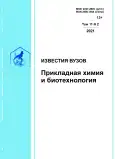Study on efficiency of corrosion inhibitors based on derivatives of isothiuronic salts
- 作者: Ushakov I.A.1, Nikonova V.S.1, Polynskii I.V.2, Knyazeva L.G.3, Polynskaya M.M.4, Antsiferov E.A.3
-
隶属关系:
- A.E. Favorsky Irkutsk Institute of Chemistry SB RAS
- Irkutsk National Research Technical University
- All-Russian Scientific Research Institute for the Use of Machinery and Oil Products in Agriculture
- Irkutsk State Transport University
- 期: 卷 11, 编号 2 (2021)
- 页面: 326-332
- 栏目: Brief communication
- URL: https://journals.rcsi.science/2227-2925/article/view/300933
- DOI: https://doi.org/10.21285/2227-2925-2021-11-2-326-332
- ID: 300933
如何引用文章
全文:
详细
作者简介
I. Ushakov
A.E. Favorsky Irkutsk Institute of Chemistry SB RAS
Email: ushakov@irioch.irk.ru
V. Nikonova
A.E. Favorsky Irkutsk Institute of Chemistry SB RAS
Email: vahrina@irioch.irk.ru
I. Polynskii
Irkutsk National Research Technical University
Email: polinigor@yandex.ru
L. Knyazeva
All-Russian Scientific Research Institute for the Use of Machinery and Oil Products in Agriculture
Email: knyazeva27@mail.ru
M. Polynskaya
Irkutsk State Transport University
Email: marypo1976@yandex.ru
E. Antsiferov
All-Russian Scientific Research Institute for the Use of Machinery and Oil Products in Agriculture
Email: antsiferov@istu.edu
参考
- Sharma S., Kumar A. Recent advances in metallic corrosion inhibition: A review // Journal of Molecular Liquids. 2021. Vol. 322. P. 114862. https://doi.org/10.1016/j.molliq.2020.114862
- Ozcan M., Dehri I., Erbil M. Organic sulphur-containing compounds as corrosion inhibitors for mild steel in acidic media: correlation between inhibition efficiency and chemical structure // Applied Surface Science. 2004. Vol. 236. Issue 1-4. P. 155164. https://doi.org/10.1016/j.apsusc.2004.04.017
- Musa A.Y., Kadhum A.A.H., Mohamad A.B., Rahoma A.A.B., Mesmari H. Electrochemical and quantum chemical calculations on 4,4-dimethyloxazolidine-2-thione as inhibitor for mild steel corrosion in hydrochloric acid // Journal of Molecular Structure. 2010. Vol. 969. Issue 1-3. P. 233237. https://doi.org/10.1016/j.molstruc.2010.02.051
- Sudheer S., Quraishi M.A. 2-Amino-3,5-dicarbonitrile-6-thio-pyridines: new and effective corrosion inhibitors for mild steel in 1 M HCL // Industrial & Engineering Chemistry Research. 2014. Vol. 53. Issue 8. P. 2851-2859. https://doi.org/10.1021/ie401633y
- Li X., Deng S., Fu H. Allylthiourea as a corrosion inhibitor for cold rolled steel in H3PO4 solution // Corrosion Science. 2012. Vol. 55. P. 280-288. https://doi.org/10.1016/j.corsci.2011.10.025
- Quraishi M.A., Ansari F.A., Jamal D. Thiourea derivatives as corrosion inhibitors for mild steel in formic acid // Materials Chemistry and Physics. 2003. Vol. 77. Issue 3. P. 687-690. https://doi.org/10.1016/S0254-0584(02)00130-X
- Fekry A.M., Mohamed R.R. Acetyl thiourea chitosan as an eco-friendly inhibitor for mild steel in sulphuric acid medium // Electrochimica Acta. 2010. Vol. 55. Issue 6. P. 1933-1939. https://doi.org/10.1016/j.electacta.2009.11.011
- Gao Z., Cao X., Liu L., Fang Y., Hu L. Properties of organic/inorganic hybrid coatings formed on X. magnesium alloy surface // Chinese Journal of Materials Research. 2017. Vol. 31. Issue 3. P. 211218. https://doi.org/10.11901/1005.3093.2016.240
- Korkmaz N., Obaidi O.A., Senturk M., Astley D., Ekinci D., Supuran C.T. Synthesis and biological activity of novel thiourea derivatives as carbonic anhydrase inhibitors // Journal Enzyme Inhibition and Medicinal Chemistry. 2015. Vol. 30. Issue 1. P. 75-80. https://doi.org/10.3109/14756366.2013.879656
- El-Faham A., Osman S.M., Al-Lohedan H.A., El-Mahdy G.A. Hydrazino-methoxy-1,3,5-triazine derivatives' excellent corrosion organic inhibitors of steel in acidic chloride solution // Molecules. 2016. Vol. 21. Issue 6. P. 714-727. https://doi.org/10.3390/molecules21060714
- Torres V.V., Rayol V.A., Magalhaes M., Viana G.M., Aguiar L.C.S., Machado S.P., et al. Study of thioureas derivatives synthesized from a green route as corrosion inhibitors for mild steel in HCl solution // Corrosion Science. 2014. Vol. 79. P. 108-118. ttps://doi.org/10.1016/j.corsci.2013.10.032
- Shahabia S., Norouzi P., Ganjali M.R. Electrochemical and theoretical study of the inhibition effect of two synthesized thiosemicarbazide derivatives on carbon steel corrosion in hydrochloric acid solution // RSC Advances. 2015. Vol. 5. Issue 27. P. 20838-20847. https://doi.org/10.1039/c4ra15808c
- Levanova E.P., Grabel'nykh V.A., Vakhrina V.S., Russavskaya N.V., Albanov A.I., Korche-vin N.A., et al. Synthesis of new 2-(alkenyl-sulfanyl)pyrimidine derivatives // Russian Journal of Organic Chemistry. 2014. Vol. 50. Issue 3. P. 429433. https://doi.org/10.1134/S1070428014030221
- Рахманкулов Д.Л., Бугай Д.Е., Габитов А.И., Голубев М.В., Лаптев А.Б., Калимуллин А.А. Ингибиторы коррозии. Т. 1. Основы теории и практики применения. Уфа: Реактив, 1997. 296 с.
- Березовский В.И., Сосновская Н.Г., Добрынина Н.Н. Применение изотиурониевых солей в качестве блескообразующих добавок при меднении // Современные технологии и научно-технический прогресс 2020. Т. 1. N 7. С. 19-20. https://doi.org/10.36629/2686-9896-2020-1-19-20
- Сосновская Н.Г., Истомина Н.В., Синегов-ская Л.М., Розенцвейг И.Б., Корчевин Н.А. Электроосаждение блестящих никелевых покрытий из сульфатного электролита в присутствии изо-тиурониевыхсолей // Гальванотехника и обработка поверхности. 2019. Т. 27. N 4. С. 4-11. https://doi.org/10.47188/0869-5326_2019_27_4_4
- Алцыбеева А.И., Левин С.3. Ингибиторы коррозии металлов / под ред. проф. Л.И. Антропова. Л.: Химия, 1968. 264 с.
- Kozaderov O.A., Koroleva O.V., Vvedenskii A.V. Kinetics of phase transformations in a binary alloy surface layer at the selective dissolution. I. Theoretical analysis // Protection of Metals and Physical Chemistry of Surfaces. 2009. Vol. 45. Issue 1. P. 31-35. https://doi.org/10.1134/S2070205109010043
- Kuznetsov Yu.I., Makarov D.A., Vershok D.B. Accelerater of steel oxidation in ammonium nitrate solutions // Protection of Metals. 2004. Vol. 40. Issue 1. P. 3-6. https://doi.org/10.1023/B:PROM.0000013104.66432.fe
- Kharitonov D.S., Kurilo I.I., Zharskii I.M. Effect of sodium vanadate on corrosion of AD31 aluminum alloy in acid media // Russian Journal of Applied Chemistry. 2017. Vol. 90. Issue 7. P. 10891097. https://doi.org/10.1134/S1070427217070102
补充文件









